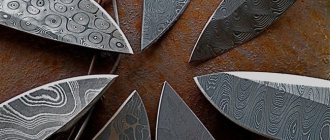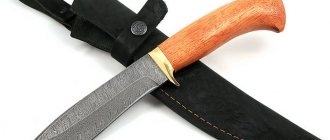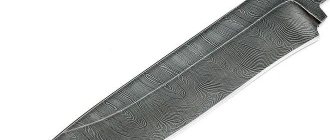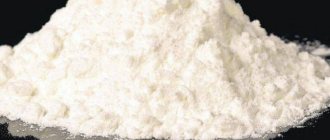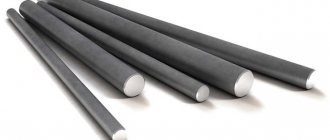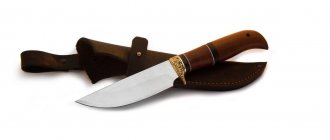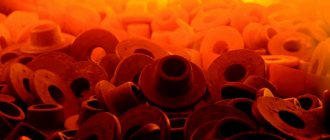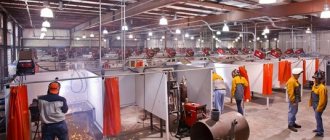Any steel has certain properties inherent only to a specific brand. And metallurgists try to make every effort to obtain the highest and highest quality characteristics of the material. But, since it is not entirely possible to obtain an ideal steel structure, it all comes down to selecting the optimal capabilities for certain purposes. After all, everyone knows that a knife made of soft steel is easier to sharpen than one made of harder steel. Hard steel, on the contrary, is highly resistant to mechanical stress.
With a complex chemical composition, the production process of steel itself slows down, which is why the cost of the finished product increases.
The quality of a knife may not always depend on a specific grade of steel. High-quality heat treatment of the product plays a big role here . The most popular steel for making knives is considered to be 40x13 steel. It has all the necessary properties and characteristics.
The main thing in a knife is steel
Anyone planning to buy a knife should take its choice very seriously.
After all, a knife must be a faithful and reliable tool that will not fail at the right time. It is not enough that the knife is beautiful, comfortable, has an interesting design, or bears the mark of a famous manufacturer. In this article, we will tell you how a person who does not understand the grades and compositions of steel cannot make a mistake when choosing a knife.
Most knife manufacturers prefer stainless steel. Not surprisingly, stainless steels are more resistant to various types of corrosion, therefore they retain their working properties and pleasant appearance longer.
The most popular domestic grades of stainless steel are:
More details about each of them:
Review of popular models
Taking into account the main technical and operational characteristics, as well as relying on the opinions of real users and specialists, we have compiled a small rating of knives made of 65X13 steel.
Knight
Gift knife in the mid-price category. The 65X13 stainless steel blade allows you to reliably protect the blade from corrosion. Its high carbon content makes it durable and shock-resistant.
The elegant hilt perfectly complements and extends the blade. The small guard and pommel are made of metal, plated with gold and polished to a mirror shine.
The middle part of the handle is made of wenge-colored walnut and has radial grooves for a more comfortable grip.
Specifications:
- blade material – steel 65Х13;
- handle material – steel with wooden overlay;
- knife length, mm – 277;
- blade length, mm – 151.
Wolf
A hunting knife belonging to the middle price category. The blade is made of stainless steel 65X13, which provides high corrosion resistance and wear resistance. In front of the heel of the blade there is a small saw that will do an excellent job with small branches. On both sides of the blade, along the axis, there are longitudinal grooves, which not only lighten the weight of the blade, but also give it additional rigidity.
The guard with wooden overlays makes it easy to grip and hold the knife in your hand, and also ensures high performance.
The metal top has a through hole for attaching a safety belt or carabiner.
Specifications:
- blade material – steel 65Х13;
- handle material – steel with wooden overlay;
- knife length, mm – 305;
- blade length, mm – 187.
Shark
A universal knife in the mid-price segment. Perfect for use in hunting, fishing, as well as for household needs. The forged blade is made of hardened grade 65X13. Partial sharpening of the top edge provides additional ease of use.
The hilt is made of walnut. To improve performance, before installation they were dried and steamed in accordance with special technology. The absence of a guard is compensated by the ergonomic shape of the handle, which provides a comfortable grip of the knife in the user’s hand. For additional convenience, there is a through hole in the back of the handle for installing a safety belt. In addition to the knife itself, the delivery set includes a sheath made of genuine leather.
Specifications:
- blade material – steel 65Х13;
- handle material – steel with wooden overlay;
- knife length, mm – 255;
- blade length, mm – 135.
Steel 95x18
The composition of this steel was invented not so long ago, but it is already very popular due to its corrosion-resistant properties.
The 19% chromium and 1% carbon included in the steel provide it with high resistance to humid environments, which allows, with proper care, to completely avoid rusting of the blade.
Despite the fact that in industry this steel is used to make durable parts that require increased wear resistance, knives made from 95x18 steel are very easy to care for. Knives made from this steel are famous for their ease of sharpening, which is important for an inexperienced user.
Also, due to the chromium contained in it, this steel is ideal for forging. Forging metal helps to get rid of such defects as microcracks or filling of pores with elements of hydrogen and oxygen, which can lead to a decrease in the anti-corrosion properties of steel. Also during forging, the grain of the metal is refined. Due to this, ductility increases, while its strength does not decrease. This is especially important when making knives, since after forging a knife made of 95x18 steel is able to withstand heavy loads even in bending.
Not all knife manufacturers use forged steel 95x18 in their products, replacing it with the so-called “rolled” 95x18. This is done because rolled steel is less expensive to produce and transport, which affects its price. Although the chemical composition of these steels is identical, forged steel is more valuable due to its density. When rolling steel, it is impossible to completely get rid of microcracks and cavities, as this happens during forging, and therefore there is no guarantee that defects will not appear on the product over time. When choosing a knife made of 95x18 steel, be sure to pay attention to this and, if necessary, check with the seller.
When talking about domestic steel 95x18, one cannot fail to mention its foreign analogue - AUS-8 steel.
Making a knife from a file
Making a knife from a file should begin by tempering the steel. The material of the original tool is fragile and hard, so it must be heated to 200 C, kept there for about an hour, and then allowed to cool on its own. Sometimes the file is simply thrown into the fire, but it is much easier to let it go in a regular oven.
Using a pre-prepared template, we cut out the shape of a knife - a grinder or milling cutter is suitable for this. When working with emery, there is a high risk of overheating the metal. A sign of metal overheating during cutting is a change in color. To cool, simply spray the cutting area with water.
After this, you can start sanding the contour with the same grinder - cut off the corners and protrusions. The work can also be done using a belt sander.
The next stage is making bevels, before which you need to draw a boundary line on the blade. Do not forget that the angle should not be too large and too small - in the first case the blade will be too thick, in the second it will be thin and fragile. To form bevels, it is better to use a tape machine; a grinder is also allowed. The final finishing is done with files. Don't forget to monitor the temperature!
Steel AUS-8
AUS-8 steel composition
developed by Japanese metallurgists and meets Japanese standards. Steel, AUS-8 is considered the most popular Japanese stainless steel and is widely used by knife makers around the world. But in essence, its composition is not much different from the composition of our steel 95x18, carbon in AUS-8 is 0.7%, and chromium 14%. Speaking about the properties of this steel, some craftsmen note that AUS-8 steel occupies an intermediate place between Damascus steels and stainless steels. It is quite durable and little susceptible to aggressive and humid environments. Knives made from AUS-8 steel are considered the most “working”, since they retain their working properties for a long time, keep the cutting edge sharp for a long time, but are easy to sharpen. So, if you use a knife for professional purposes, then a knife made of AUS-8 steel is what you need.
Recommendations for heat treatment 40Х10С2М
Proper heat treatment plays an important role in preserving the qualities of the metal. After any thermal operation, the 40Х10С2М alloy must be annealed. This process is carried out at a temperature of 860 °C. And followed by slow cooling in a gradually cooling oven.
Steel forging is carried out at temperatures of 900-1200 °C. Afterwards, the steel must be tempered to relieve stress in the alloy. As already mentioned, to carry out welding work, the metal is first heated. And only then are they welded. And after the procedure they definitely anneal it.
Steel 65x13
Steel 65x13 is considered the most popular among domestic knife manufacturers. They, as well as users, prefer it due to its resistance to various types of corrosion and low price. The steel contains 13% chromium and only 0.6% carbon; therefore, this steel is less susceptible to corrosion than 95x18, but differs greatly in ductility. Steel 65x13 is more ductile and therefore holds the cutting edge worse, but at the same time sharpening it will not pose a problem even for a completely inexperienced user. Moreover, many users claim that you can even straighten a knife made of 65x13 steel “on your knees” in the field with an ordinary cobblestone. This is undoubtedly very important for tourists and hunters.
Making a knife from a bearing race
To make such a knife, you can use a cardan shaft bearing, machine bearings, the holder of which is made of steel type ШХ15. To obtain a workpiece, it is better to immediately saw the outer frame at an angle in order to obtain a workpiece under the nose of the knife. The circumference should be slightly larger than the total length of the knife, so leave a margin of about 2 cm.
Alloy steel requires annealing before forging. To straighten it, just keep it heated to a dark red color and let it cool in the air. After this, you will need to heat the workpiece to 800 C - the cherry-red color indicates its achievement. If the metal has turned dark orange, the upper temperature limit of 1100 C has been reached. As soon as the color changes to dull cherry, heating in the oven should be repeated.
How to forge a knife
There are two options for forging a knife. The first is for experienced professionals who know how to handle a hammer. The metal must be beaten so that it moves from the middle to the edge, and the tip must be rounded, stretching the workpiece along its length.
The second method is a little simpler - the plate is given a flat shape with a hammer, after which it is roughed with a grinder. This process is similar to that previously described, but the craftsman should ensure that the metal is cut in small pieces.
How to harden and temper knife metal
Bearing steel requires [hardening and tempering], so you will need to control the heating of the metal - salt poured onto the blade will begin to melt at a temperature of 800 C. After this, the workpiece is placed in heated oil, being careful, as ignition is likely. When hardening, do not add oil or shake it, or turn the workpiece over. After hardening, the metal is tempered by heating to 200 C and gradually cooling. Subsequent operations for sharpening, finishing and assembling the knife are described above.
Steel 40x13
Steel 40x13 can safely be called the first among stainless steels. Knives that are constantly exposed to aggressive environments are mainly made from this steel: kitchen knives, specialized knives for divers, water rescuers and fishermen. Knives made from 40x13 steel really do not rust, but due to the low carbon content, only 0.4%, they are more ductile and flexible. Therefore, it is strongly recommended not to use knives with this steel for working on hard materials. 40x13 steel has firmly occupied the niche of various kitchen knives, fishing knives and knives for city picnics.
Powdered stainless steels should be included in a separate group.
Powdered stainless steels
The production of such steels is a new word in metallurgy. And the production of knives from powder steels is a rather complex and unusual process. Products made from powder steel have improved characteristics in such matters as corrosion resistance, wear resistance and can be used in various conditions. Many experts and craftsmen have noted that today, knives made from powder steels have better quality, properties and characteristics than knives made from other materials. Read more about powder steels here (link)
Source
Types of knives by purpose
First, you need to figure out what metal the knife should be made of, and to do this, determine the purpose of the blade. There are four main types of knives, differing in sharpening, weight and other characteristics.
Hunting - with a very sharp blade, the tip precisely shaped to shape. Knives of this type require careful selection of steel, as they must remain sharp for a very long time. In addition, steel for a hunting knife requires high toughness, since the blade may collide with bone when cutting.
Tourist and hiking ones - must have serious weight and strength, since they usually perform rough work with branches and other objects. This is an analogue of an ax, so it is important to maintain a balance between the hardness of the steel and its resistance to impact and fracture.
Kitchen knives are very close in type to kitchen knives, with the obligatory selection of high-hardness steel. A kitchen knife should not chip when colliding with a bone or become dull when working on a plastic board.
Cleavers and survival knives are the successors to axes and camping knives. The former have a significant mass and width of the blade, the latter must be universal. This is especially difficult, since the functions are often incompatible, for example, as with tourist and hunting knives.
It is worth paying special attention to the choice of source material. In terms of the amount of work involved, the easiest way to make a knife is from a file - it already has a certain similar shape. In terms of strength and wear resistance - from a spring, spring or bearing. Sheet steel is selected from grades for these products. The sharpening angle of the knife is selected depending on the purpose, for example, a tourist knife is sharpened at 25 - 30 degrees, and a kitchen knife at 8 - 15 degrees.
All about steel 65Х13
Steel grade 65X13 is used for the manufacture of knives and other cutting instruments for medical and household purposes. The decoding of its name indicates the presence of chromium in the composition, which affects the characteristics of the material, its Rockwell hardness, pros and cons. A full review, as well as a comparison with steel 95X18 and 40X13, will help you appreciate it.
Reviews
The popularity of products made from 40x13 steel is confirmed by numerous reviews from tool users. Such properties as sharpness and ease of sharpening are especially noted. Many also like the ease of maintenance and anti-corrosion properties.
A lot of feedback comes from medical workers, in particular from surgeons. It’s not for nothing that the material is called medical steel.
Thrifty housewives note that this is quite suitable steel for household purposes, subject to normal heat treatment. Some have been using knives for about 20 years, and even take them on hikes. The tool has never failed. Particularly pleasing is the easy sharpening with any available tools.
Manicurists and hairdressers like tools made from medical steel. They also note the durability of 40x13 steel products. Nippers and other cutting tools are needed to give nails a certain shape and neatness. A manicurist with ten years of experience admires its durability: the tool remains sharp for a long time and does not deform when sharpened.
Manicure tool made of steel 40X13.
We must not miss the point that any, even the most durable thing, requires that it be treated carefully and comply with the minimum requirements. Knife blades, for example, do not like to be stored in damp conditions. Do not leave the surface dirty. If you neglect these rules, rust appears on the blades. It can be removed when sharpening, but durability will suffer.
Compound
The description of steel grade 65X13 for knives and other cutting elements allows you to get a complete understanding of its features and capabilities. The material is made from an alloy of components presented in the following proportions:
- Fe is the main volume fraction;
- C - 0.60–0.70%;
- Cr – about 12–14%;
- Mn – 0.25–0.80%;
- P – less than 0.30%;
- S – up to 0.025%;
- Si – 0.2–0.5%.
The higher the quenching temperature, the greater the amount of carbon and chromium will be contained in the composition.
Additionally, the alloy may include alloying components in the form of molybdenum, tungsten, vanadium, and manganese.
Such additives can affect the structure of steel, its strength, and other characteristics.
Explanation of markings
EI 107 steel is produced in Zlatoust. The type of supply is varied: round and square rods, long products, castings and strips, circles of various diameters.
The letters in the alloy under the new marking 40Х10С2М indicate the presence of the following elements: chromium, silicon and molybdenum. The numbers after the letters give an estimate of the content of these elements in percentage quantitative composition:
- X (chrome) – 9-10.5%;
- Si (silicon) – 1.9-2.6%;
- M (molybdenum) – 0.7-0.9%.
Characteristics and properties
Decoding the name of steel 65Х13 is quite simple. The letter X means the presence of chromium, the number after it is the percentage of this element. You can also understand from the designation that carbon is present in the composition in a volume of 0.65%. The Rockwell hardness of the material is 56-59 HRC, which is a fairly high value for a metal.
The main GOST 5632-72 relevant for marking steel 65X13. Additionally, manufacturers can use specifications to produce material for specific purposes. Quality is affected by deformation effects. For this brand they are made in cold and hot forms.
The properties of steel 65Х13 usually include the following indicators:
- excellent cutting properties;
- high quality sharpening;
- hardening, allowing the formation of a monolithic alloy;
- long service life;
- absence of metal fragility;
- flexibility during processing.
The set of properties is influenced by the composition of the material.
The presence of alloying additives is individual; some of them, such as tungsten or molybdenum, are used only in expensive models of professional and medical knives.
The material is also capable of withstanding repeated processing in autoclaves and disinfection, which makes it the optimal choice for creating medical instruments.
Advantages and disadvantages
Despite all its positive qualities, 65X13 steel is not without its drawbacks. For greater convenience, they have all been combined into one table.
| Advantages | Flaws |
| Impact strength . Knives made from this steel do not break or crack when dropped or as a result of an impact. | Hardness _ During the hardening process, the blade blade acquires a hardness of 56 -59 HRC. Therefore, rapid grinding of the factory edge occurs. |
| Corrosion resistance . Thanks to alloying with chromium and nickel, steel does not rust during prolonged contact with water or other aggressive liquids. | Sensitivity to compliance with the manufacturing process . Failure to comply with the manufacturing and hardening process inevitably leads to increased fragility and decreased wear resistance of the metal. |
| Heat resistance . Even with prolonged contact with open fire, the metal does not change its properties. Changes in the properties of steel occur under the influence of high temperatures, which are very difficult to achieve in everyday conditions. | |
| Ease of processing . Average hardness values for its class ensure maximum ease of metal machining. | |
| Price . A small amount of alloying components and a simplified hardening process made it possible to reduce the final cost of steel. | |
| Range of applications. The peculiarities of the chemical composition provided steel 65Х13 with a wide range of applications. | |
| Appearance. Knife blades made of this steel do not fade for a long time and retain their natural shine. |
Areas of application
Steel of this grade is considered the optimal choice for the manufacture of knives, blades, and medical cutting instruments. Among the products created with its help, the following groups of products can be distinguished.
- Cutting . This includes professional chef's and amateur knives, which are used to cut carcasses and pieces of meat, fish, and other dense and fibrous products.
- Kitchen . Knives for household use, serve for a long time, are available in a wide size range.
- Tourist . They are characterized by an increased blade thickness and are suitable for splitting hard and dense materials, including wood. They are characterized by a balanced weight ratio between the handle and the cutting part.
- Hunting . Massive, with a specially shaped blade, they are well suited for use in conditions remote from civilization. Knives are used as cutting knives and can also serve in other capacities. They have a wide blade and a significant cutting edge area.
- Pen pockets . Folding knives with a narrow blade that can be stored inside the handle. Most often used for tourism and domestic purposes.
- Razor blades . Steel 65X13, even in the form of very thin blades, provides a high sharpness of the cutting edge. It withstands contact with a humid environment and does not dull too quickly.
- Medical instruments . Lancets and scalpels, saw blades for surgical operations are made from this steel.
Conclusion
Safe and widely used steel suitable for common kitchen knives . You can’t do without them in your household - they are easy to care for, easy to sharpen, and have stainless properties. Cutting any food is not difficult at all. Sufficient hardness of the knife body, sharp edge, and not too wide knife will allow you to thinly slice any product.
Widely used in everyday life - a knife on the kitchen table, a scalpel in the hands of a surgeon, measuring devices, springs, shafts, household products, and industry.
| ✅ Manufacturer | Knight |
| ✅ Total length | 202 mm |
| ✅ Blade length | 102 mm |
| ✅ Handle material | Bakelite |
The tourist folding knife looks decent and is of appropriate quality, despite the low price. The wide blade with a 2.1 mm spine has high slopes and a thin tip, which allows for smooth, precise cuts. The bakelite handle fits comfortably in the hand thanks to the classic grooves. And the metal guard and pommel reliably protect the bakelite part of the handle from damage.
Gudgeon
| ✅ Manufacturer | Knight |
| ✅ Total length | 220 mm |
| ✅ Blade length | 114 mm |
| ✅ Handle material | Tree |
This multi-purpose tool will come in handy when camping and for performing most household tasks. The blade here is fixed, made of the considered steel 40x13, therefore it has all its pros and cons. The handles are wooden, with an easily recognizable texture. The guard is metal and serves to protect the hand from slipping and the main part of the handle from damage. “Gudgeon” is supplied complete with a textile case made of cordura.
Mosquito
| ✅ Manufacturer | Knight |
| ✅ Total length | 120 mm |
| ✅ Blade length | 60 mm |
| ✅ Handle material | Tree |
The 40x13 butcher knife is hardened to 54-56 HRC and has a good ratio of hardness and elasticity. “Mosquito”, like other thrust knives, is intended for self-defense, but is not a bladed weapon. Its compactness and lightness (70 g) are convenient for everyday wear. The shape of the handle and the large finger cutout provide a secure, firm grip.
Midshipman
| ✅ Manufacturer | Pirate |
| ✅ Total length | 220 mm |
| ✅ Blade length | 100 mm |
| ✅ Handle material | Tree |
“Michman” is not just a folding tool, but more of a multifunctional tool. The main element is a full-fledged blade with a hardness of 55 HRC, which opens using a nail hook. There is also a corkscrew, bottle opener and can opener. All elements are made of steel 40x13. The folding mechanism has a built-in Back lock - simple, but strong and reliable. The handles are made of wood; the pommel has a narrow hole for a lanyard.
Flint
| ✅ Manufacturer | Pirate |
| ✅ Total length | 200 mm |
| ✅ Blade length | 83 mm |
| ✅ Handle material | Ebony |
An automatic folding device is useful on a hike, at home or in urban environments. The versatility is largely ensured by the successful shape of the blade, high slopes, and a razor-sharp blade. The Plunge-lock lock provides reliable fixation in the open and closed state. The handles are made of black (ebony) wood, firmly secured with metal rivets.
Rimbaud
| ✅ Manufacturer | Pirate |
| ✅ Total length | 395 mm |
| ✅ Blade length | 250 mm |
| ✅ Handle material | Cord wrapping |
A true survival tool. The butt is not smooth, but has deep teeth, which allows the tool to be used as a file. The guard performs the task of a Phillips and flathead screwdriver. The handle is wrapped with synthetic thread for a rigid grip on the hand, and on the pommel there is a special metal element with a hole for a lanyard.
The pommel unscrews, and a compass and a plastic container are hidden inside the handle. The container contains a good emergency supply: adhesive plaster, matches, fishing line and hook. “Rimbaud” is supplied complete with a leather case.
Target
| ✅ Manufacturer | Nozhemir |
| ✅ Total length | 240 mm |
| ✅ Blade length | 142 mm |
| ✅ Handle material | Stainless steel |
A set of 3 throwing knives, as expected, made of 40x13 steel. For throwing you need a reliable tool that is not afraid of shock loads, with an optimal ratio of hardness and flexibility. This is exactly what Michel knives are thanks to the correct processing of the alloy. Each blade is decorated with original engraving. Deep valleys and a properly aligned center of gravity help maintain the flight path. The set comes in a folding cordura case with 3 compartments.
Atacama-2
| ✅ Manufacturer | KNOX |
| ✅ Total length | 370 mm |
| ✅ Blade length | 230 mm |
| ✅ Handle material | Nut |
A serious survival tool used as a knife, ax or machete. The shape of the blade actually resembles the famous edged weapon – the machete. It is convenient to rest your hand on the butt, which is as much as 5 mm thick, when performing heavy cutting work. For safety, there is a reliable long guard and finger grooves on the butt. The non-slip surface of the wooden handle also prevents your hand from slipping. Supplied complete with a nylon case.
Frenchman
| ✅ Manufacturer | Viking Nordway |
| ✅ Total length | 230 mm |
| ✅ Blade length | 100 mm |
| ✅ Handle material | Wood, steel |
This lightweight, elegant folding knife is useful for daily carry or for use in natural conditions. The narrow blade lends itself well to sharpening to a razor sharpness and is not afraid of mechanical stress. The bevel on the butt and the finely pointed point ensure a correct, controlled cut. The wooden handle has shallow grooves for a comfortable grip, a recognizable original texture, and does not get cold on the hand. A nail hook is provided for opening.
Novgorod
| ✅ Manufacturer | Knight |
| ✅ Total length | 269 mm |
| ✅ Blade length | 140 mm |
| ✅ Handle material | Metal, plywood |
A working knife is useful for any cutting work in nature: while hiking, hunting or fishing. The fixed blade is hardened to 56 HRC, has optimal impact strength, and can be sharpened with standard abrasives. The name of the model and manufacturer's brand is engraved in the area of the canvas. There is also patterned engraving on the metal guard. A nylon case is provided for storage and transportation.
Sources used:
- https://vashnozh.ru/stal/40×13
- https://plusiminusi.ru/stal-40×13-dlya-nozhej-plyusy-i-minusy/
- https://muzhskie-hobby.ru/luchshie-nozhi-iz-stali-40h13/
Analogs
There are quite a few steels used in the manufacture of knives. The following options are considered analogues of the 65X13 brand in different countries of the world.
- Swiss AEB-L . Corrosion steel produced by UDDELHOLM AG. Its main purpose is the manufacture of knives, razor blades, and surgical instruments. A distinctive feature of the brand is the minimum content of impurities in the form of sulfur and phosphorus, the metal is cleaner, and the cutting edge of products made from it provides increased resistance to loss of sharpness.
- American 440A . According to US standards, this variety of chrome-plated steel is also sometimes labeled 440, without the lettering. The strength of the material depends on the quality of hardening. The differences of this brand include the carbon content of 0.65–0.75%, chromium – 16–18%, which slightly improves the quality of products made from it in comparison with the domestic analogue. Magnesium, molybdenum, silicon are used as alloying components; there is phosphorus and sulfur within acceptable limits.
- German X55CrMo14. Steel with a medium carbon content (0.42–0.52%) and a high volume of chromium in the composition - up to 15%. The material turns out to be less durable and is used in the manufacture of souvenir or collection items.
- Japanese AUS6. The carbon content in it is 0.55–065%, chromium – from 13 to 14.5%. Steels of this grade are produced by Aichi Steel Works, hardening occurs to 54–57 HRS, which is also not much different from the Russian analogue. This option is widely used in the manufacture of folding and kitchen knives.
These materials are very similar in their characteristics. All of them are considered specialized knife tools and are used to create blades and blades for various purposes.
Knives made of springs and sheet steel
The blades are made in almost the same way as the previous ones, but the master must take into account that different types of metal require selection of temperature, hardening and tempering. This depends on the specific workpiece material. You can get information from metalworking reference books.
We remind you that making a knife can be regarded as making a bladed weapon, so we do not provide detailed instructions!
Source of the article: https://rezhemmetall.ru/osnovnye-nyuansy-i-etapy-pri-kovke-nozha.html
